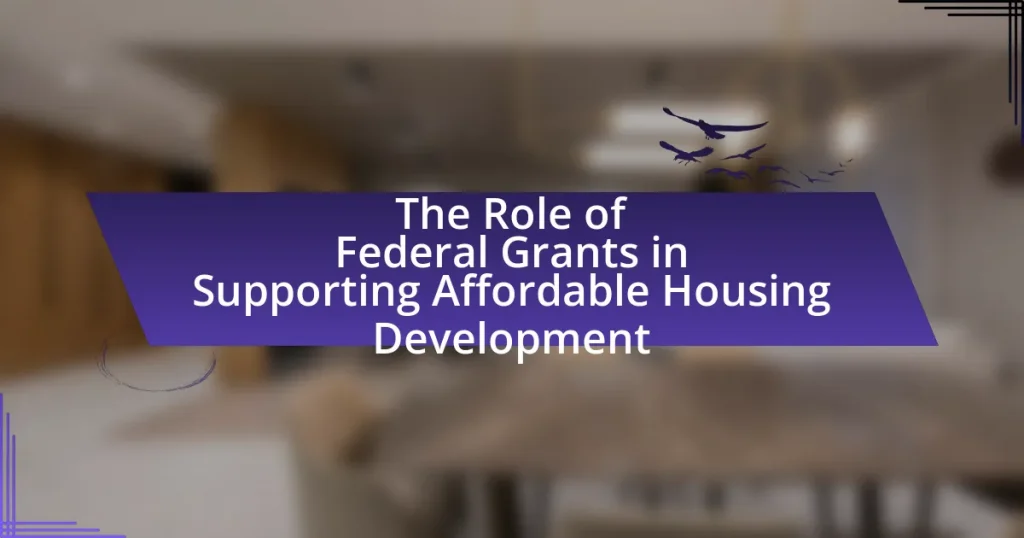Regulatory frameworks in affordable housing financing are essential guidelines and policies established by governments to enhance the development and accessibility of affordable housing for low- and moderate-income families. This article examines how these frameworks, including zoning laws, financial incentives, and compliance requirements, influence housing financing and availability. It highlights key components such as building codes and financing regulations, discusses the challenges faced by these frameworks, and explores best practices for improvement. Additionally, the article analyzes successful international examples and practical steps stakeholders can take to navigate regulatory complexities in affordable housing financing.

What are Regulatory Frameworks in Affordable Housing Financing?
Regulatory frameworks in affordable housing financing are structured guidelines and policies established by governments and regulatory bodies to facilitate the development and accessibility of affordable housing. These frameworks typically include zoning laws, financial incentives, and compliance requirements that aim to ensure that housing is affordable for low- and moderate-income families. For instance, the Low-Income Housing Tax Credit (LIHTC) program in the United States provides tax incentives to private developers to create affordable rental housing, demonstrating how regulatory frameworks can effectively promote affordable housing initiatives.
How do regulatory frameworks influence affordable housing financing?
Regulatory frameworks significantly influence affordable housing financing by establishing the rules and guidelines that govern funding sources, lending practices, and investment incentives. These frameworks can dictate the availability of public funding, tax credits, and subsidies, which are crucial for making affordable housing projects financially viable. For instance, the Low-Income Housing Tax Credit (LIHTC) program in the United States incentivizes private investment in affordable housing by providing tax credits to developers, thereby increasing the supply of affordable units. Additionally, regulations can affect the risk assessment criteria used by lenders, impacting their willingness to finance affordable housing projects. Studies have shown that jurisdictions with supportive regulatory environments tend to attract more investment in affordable housing, leading to better outcomes in housing availability and affordability.
What key components make up regulatory frameworks in this context?
Key components that make up regulatory frameworks in affordable housing financing include zoning laws, building codes, financing regulations, and compliance requirements. Zoning laws dictate land use and density, ensuring that housing developments align with community planning goals. Building codes establish safety and quality standards for construction, protecting residents and ensuring structural integrity. Financing regulations govern the availability and terms of loans and grants, influencing the accessibility of funds for developers and buyers. Compliance requirements enforce adherence to these laws and regulations, ensuring accountability and transparency in the housing market. These components collectively create a structured environment that facilitates affordable housing development while safeguarding public interests.
How do these components interact with housing finance systems?
Regulatory frameworks interact with housing finance systems by establishing guidelines that govern lending practices, risk assessment, and borrower eligibility. These frameworks ensure that financial institutions adhere to standards that promote responsible lending, thereby enhancing the stability of the housing market. For instance, regulations such as the Dodd-Frank Act in the United States impose requirements on lenders to assess a borrower’s ability to repay, which mitigates the risk of defaults and promotes sustainable homeownership. Additionally, regulatory frameworks often include provisions for affordable housing initiatives, which facilitate access to financing for low-income households, thereby increasing overall housing affordability and stability in the market.
Why are regulatory frameworks essential for affordable housing?
Regulatory frameworks are essential for affordable housing because they establish guidelines that ensure equitable access to housing resources and protect the rights of both developers and residents. These frameworks facilitate the creation of affordable housing by providing incentives such as tax credits, zoning allowances, and funding opportunities, which are crucial for attracting investment. For instance, the Low-Income Housing Tax Credit program in the United States has successfully financed over 3 million affordable housing units since its inception in 1986, demonstrating the effectiveness of regulatory support in addressing housing shortages.
What role do they play in ensuring housing accessibility?
Regulatory frameworks play a crucial role in ensuring housing accessibility by establishing guidelines and standards that promote affordable housing development. These frameworks often include zoning laws, building codes, and financial incentives that facilitate the construction and maintenance of low-income housing. For instance, the Low-Income Housing Tax Credit program in the United States has been instrumental in financing affordable housing projects, resulting in the creation of over 3 million affordable housing units since its inception in 1986. By providing a structured approach to housing policy, regulatory frameworks help to mitigate barriers to access, ensuring that diverse populations can secure safe and affordable living conditions.
How do they impact the affordability of housing options?
Regulatory frameworks significantly impact the affordability of housing options by establishing guidelines that govern land use, zoning, and financing. These regulations can either facilitate or hinder the development of affordable housing. For instance, restrictive zoning laws may limit the types of housing that can be built, thereby reducing the supply of affordable units. According to a study by the National Association of Home Builders, areas with more flexible zoning regulations tend to have a higher availability of affordable housing, as they allow for diverse housing types and increased density. Additionally, regulatory incentives, such as tax credits or subsidies, can encourage developers to invest in affordable housing projects, further enhancing affordability.

What challenges do regulatory frameworks face in affordable housing financing?
Regulatory frameworks face significant challenges in affordable housing financing, primarily due to complex compliance requirements and inconsistent policies across jurisdictions. These complexities can deter investment by increasing costs and uncertainty for developers and financial institutions. For instance, varying zoning laws and building codes can create barriers to project approval, leading to delays and additional expenses. Furthermore, limited access to public funding and incentives can restrict the availability of affordable housing options, as seen in studies indicating that regions with more streamlined regulations often experience higher rates of affordable housing development.
How do regulatory barriers affect housing development?
Regulatory barriers significantly hinder housing development by imposing restrictions that increase costs and extend timelines for construction projects. These barriers include zoning laws, building codes, and permitting processes that can limit the types of housing that can be built, the density of development, and the overall feasibility of projects. For instance, a study by the National Association of Home Builders found that regulatory costs account for approximately 25% of the final price of a new home, illustrating how these barriers directly impact affordability and availability of housing. Additionally, lengthy approval processes can delay projects, leading to increased financing costs and reduced incentives for developers to invest in new housing.
What specific regulations hinder affordable housing projects?
Zoning laws significantly hinder affordable housing projects by imposing restrictions on land use, density, and building types. These regulations often limit the number of units that can be built, thereby reducing the availability of affordable housing. For instance, many municipalities enforce single-family zoning, which restricts the construction of multi-family units, directly impacting the supply of affordable housing options. Additionally, building codes can impose costly requirements that increase construction expenses, making it financially unfeasible for developers to pursue affordable housing projects. According to a report by the National Low Income Housing Coalition, restrictive zoning and land use regulations are among the top barriers to affordable housing development in the United States.
How can these barriers be addressed or mitigated?
Barriers in affordable housing financing can be addressed through the implementation of comprehensive regulatory frameworks that promote transparency and accessibility. Establishing clear guidelines for financing processes can reduce uncertainty for investors and developers, thereby encouraging investment in affordable housing projects. For instance, the introduction of tax incentives and subsidies has been shown to stimulate private sector participation, as evidenced by the Low-Income Housing Tax Credit program in the United States, which has financed over 3 million affordable housing units since its inception in 1986. Additionally, streamlining permitting processes and reducing bureaucratic hurdles can expedite project timelines, making it more feasible for developers to engage in affordable housing initiatives.
What are the implications of inadequate regulatory frameworks?
Inadequate regulatory frameworks lead to increased risks in affordable housing financing, resulting in financial instability and reduced access to housing. Without proper regulations, lenders may engage in predatory practices, leading to higher interest rates and fees for borrowers. For instance, the 2008 financial crisis highlighted how lax regulations allowed subprime lending to flourish, ultimately causing widespread foreclosures and economic downturn. Additionally, insufficient oversight can result in poor construction standards, compromising safety and quality in housing developments. These implications underscore the necessity for robust regulatory frameworks to ensure equitable and sustainable housing solutions.
How does a lack of regulation impact housing quality?
A lack of regulation negatively impacts housing quality by allowing substandard construction practices and inadequate maintenance. Without regulatory oversight, developers may prioritize profit over safety, leading to the use of inferior materials and neglect of essential building codes. For instance, a study by the National Housing Institute found that unregulated housing markets often experience higher rates of structural failures and health hazards, such as mold and poor air quality, which directly affect residents’ well-being. Additionally, the absence of regulations can result in insufficient tenant protections, leaving occupants vulnerable to unsafe living conditions.
What are the economic consequences of insufficient regulatory oversight?
Insufficient regulatory oversight leads to economic instability, increased risk of financial crises, and market inefficiencies. For instance, the 2008 financial crisis was significantly attributed to inadequate regulation in the housing finance sector, resulting in a loss of approximately $22 trillion in household wealth in the United States. Additionally, insufficient oversight can foster predatory lending practices, which disproportionately affect low-income communities, exacerbating economic inequality and limiting access to affordable housing. This lack of regulation can also deter investment in housing markets, as investors seek safer environments with robust regulatory frameworks, ultimately stifling economic growth and development in the housing sector.

How can regulatory frameworks be improved for better affordable housing financing?
Regulatory frameworks can be improved for better affordable housing financing by streamlining the approval processes and enhancing access to funding sources. Simplifying zoning laws and reducing bureaucratic hurdles can expedite project timelines, making it easier for developers to create affordable housing. Additionally, establishing public-private partnerships can leverage private investment while ensuring compliance with affordability standards. Evidence from the National Low Income Housing Coalition indicates that states with streamlined regulations see a 20% increase in affordable housing units developed.
What best practices exist for developing effective regulatory frameworks?
Effective regulatory frameworks should prioritize stakeholder engagement, transparency, and adaptability. Engaging stakeholders, including community members, developers, and policymakers, ensures that diverse perspectives are considered, leading to more comprehensive regulations. Transparency in the regulatory process fosters trust and accountability, allowing stakeholders to understand the rationale behind decisions. Additionally, adaptability is crucial; regulations must evolve in response to changing market conditions and societal needs. For instance, the World Bank emphasizes that regulatory frameworks should be flexible to accommodate innovations in affordable housing financing, which can enhance their effectiveness.
How can stakeholder engagement enhance regulatory effectiveness?
Stakeholder engagement enhances regulatory effectiveness by fostering collaboration and ensuring that diverse perspectives are considered in the regulatory process. Engaging stakeholders, such as community members, industry experts, and policymakers, leads to more informed decision-making, as it incorporates local knowledge and experiences that can identify potential challenges and opportunities. For instance, a study by the World Bank found that inclusive stakeholder engagement in regulatory frameworks can improve compliance rates and reduce conflicts, ultimately leading to more sustainable outcomes in sectors like affordable housing. This collaborative approach not only builds trust among stakeholders but also increases the legitimacy and acceptance of regulations, making them more effective in achieving their intended goals.
What role does technology play in improving regulatory frameworks?
Technology plays a crucial role in improving regulatory frameworks by enhancing transparency, efficiency, and compliance monitoring. Digital tools such as blockchain can provide immutable records of transactions, ensuring accountability in affordable housing financing. Additionally, data analytics enables regulators to identify trends and assess risks more effectively, leading to informed decision-making. For instance, the use of automated reporting systems reduces the administrative burden on stakeholders and increases the accuracy of compliance data. These advancements contribute to a more robust regulatory environment that supports sustainable and equitable housing solutions.
What lessons can be learned from successful regulatory frameworks in other regions?
Successful regulatory frameworks in other regions demonstrate the importance of clear guidelines, stakeholder engagement, and adaptive policies. For instance, Singapore’s Housing and Development Board (HDB) effectively combines public housing with market mechanisms, resulting in over 80% of its population living in government-subsidized housing. This model emphasizes the need for government involvement in housing markets to ensure affordability and accessibility. Additionally, Germany’s rental regulations, which include tenant protections and rent control, illustrate how regulatory measures can stabilize housing markets and prevent displacement. These examples highlight that successful frameworks require a balance between regulation and market forces, active participation from various stakeholders, and the flexibility to adapt to changing economic conditions.
Which countries have implemented effective housing regulations?
Countries that have implemented effective housing regulations include Germany, Singapore, and Sweden. Germany’s housing policies focus on tenant protection and rent control, which have contributed to stable housing markets. Singapore’s Housing and Development Board has successfully provided affordable public housing, with over 80% of the population living in government-subsidized flats. Sweden’s rental market is characterized by strong tenant rights and a regulated rent-setting system, ensuring affordability and accessibility. These countries demonstrate how effective housing regulations can lead to sustainable and affordable housing solutions.
What strategies from these countries can be applied elsewhere?
Countries with effective regulatory frameworks in affordable housing financing, such as Singapore and Germany, implement strategies that can be applied elsewhere. Singapore’s approach includes a strong public housing program that integrates various income groups, ensuring affordability and social cohesion. This model can be adapted by other nations to create inclusive housing policies that cater to diverse populations. Germany’s emphasis on long-term rental agreements and tenant protections fosters stability in the housing market, which can be replicated to enhance tenant security and reduce homelessness in other regions. These strategies demonstrate that comprehensive regulatory frameworks can effectively address housing affordability challenges globally.
What practical steps can stakeholders take to navigate regulatory frameworks in affordable housing financing?
Stakeholders can navigate regulatory frameworks in affordable housing financing by actively engaging with local and federal agencies to understand compliance requirements. This involves attending workshops and training sessions offered by regulatory bodies, which provide insights into the latest policies and funding opportunities. Additionally, stakeholders should establish partnerships with legal experts who specialize in housing regulations to ensure adherence to laws and to facilitate the application process for financing.
Furthermore, stakeholders can leverage data analytics to assess the impact of regulations on project feasibility, allowing for informed decision-making. For instance, a study by the Urban Institute highlights that understanding zoning laws and tax incentives can significantly enhance project viability. By implementing these practical steps, stakeholders can effectively maneuver through the complexities of regulatory frameworks in affordable housing financing.



